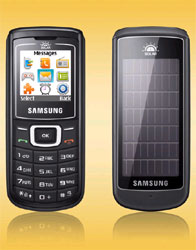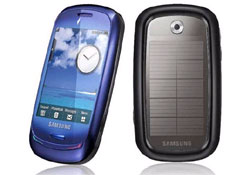Samsung launches first solar mobile handset in India, but where is ‘Blue Earth’?
11 Jun 2009
Looking to bolster its sales in rural India, Korean consumer electronics major Samsung yesterday launched a solar mobile phone, 'Solar Guru' (Guru E1107), in India, a product that should give environmentalists a reason to smile.
 The dual-charging Solar Guru phone will be a boon to people living in rural India, large parts of which either face prolonged power cuts or low voltage supply; the Guru E1107 will enable the user to talk for about 5-10 minutes by solar charging the battery for one hour under the sun through a full solar panel on the back of the handset.
The dual-charging Solar Guru phone will be a boon to people living in rural India, large parts of which either face prolonged power cuts or low voltage supply; the Guru E1107 will enable the user to talk for about 5-10 minutes by solar charging the battery for one hour under the sun through a full solar panel on the back of the handset.
Supported by an 800mAh battery, the handset can also be charged using conventional electricity.
Priced at priced at Rs2,799, the Guru E1107 comes with dual GSM bands (900 / 1800MHz), a 1.52-inches 65K CSTN screen, FM Radio, MP3 ring tones, torch, Mobile Tracker and embedded games.
Samsung India said that Solar Guru would be launched in Europe, Southeast Asia, Southwest Asia and Latin America this month.
However, the solar phone may well disappoint Samsung fans in India, who had expected the company to release its high-end 'Blue Earth' solar phone, unveiled at the mobile world congress in Barcelona in February. (See: Samsung develops solar-powered touchscreen phone)
 If Samsung hopes to capture the vast Indian rural market with its solar phones, it will soon have to bring the 'Blue Earth' solar phone to India, since its Korean rival LG, Chinese telecommunications equipment providers ZTE and Hi-Tech Wealth Inc, and Latin American service provider Digicel also unveiled solar powered mobile handsets at Barcelona. (See: Mobile phone makers moving to solar-powered handsets)
If Samsung hopes to capture the vast Indian rural market with its solar phones, it will soon have to bring the 'Blue Earth' solar phone to India, since its Korean rival LG, Chinese telecommunications equipment providers ZTE and Hi-Tech Wealth Inc, and Latin American service provider Digicel also unveiled solar powered mobile handsets at Barcelona. (See: Mobile phone makers moving to solar-powered handsets)
The company says it plans to introduce the Blue Earth by the end of this calender year.
Green phones
The Samsung 'Blue Earth' solar mobile handset has a touch screen front and a solar panel back, which if fully charged via solar power for about 10 to14 hours, give nearly 4 hours of talk time.
The body of the phone is made of recycled water bottles and has no brominated flame retardants, beryllium and phthalates, all of which are toxic substances.
The 'Blue Earth' is also energy efficient, since it has a new user interface making it easy to activate the phone's energy saving mode. It also comes with a pedometer and CO2 emissions calculator while the packaging is made entirely from recycled paper.
LG also unveiled a prototype of its solar powered clamshell phone in Barcelona. A 10-minute charge gives up to 3 minutes of talk time. Like the Samsung phone, this one too has a 360-degree green approach.
If kept in sufficient natural light, the battery will be able to power the phone for a longer time, thereby eliminating or reducing the need for a conventional charger.
The phone, made from bio-plastic, is free from six hazardous substances ? lead, cadmium, mercury, chromium 6, PBB, and PBDE. LG has also worked on the standby power consumption and even has an eco-friendly manual, which is printed with soy ink on a recycled paper.
Chinese mobile manufacturer ZTE recently unveiled the cheapest solar powered mobile handset called the Coral-200, a solar touch phone costing only $40 (Rs1,890). Using Dutch-invented technology, the Coral-200 can give about 15 minutes of talk time for every hour of solar charging.
In fact, it was China's Hi-Tech Wealth, which had manufactured the world's first solar powered mobile handset, the S116 in 2007. The phone's battery lasts 2.5 times longer than a traditional battery and can be solar-charged with one hour of sunlight to provide the user about 40 minutes of talk-time.
But what makes the S116 stand apart from other solar powered mobile handsets, is the fact that the S116 can even be charged indoors by candlelight.
Intivation, an innovative Dutch start-up company is all set to offer a solar-powered handset specifically for developing countries. The Dutch company uses an innovative converter that takes 0.5v from a solar cell and steps it up to the 3.7v needed for any lithium ion mobile phone battery.





















